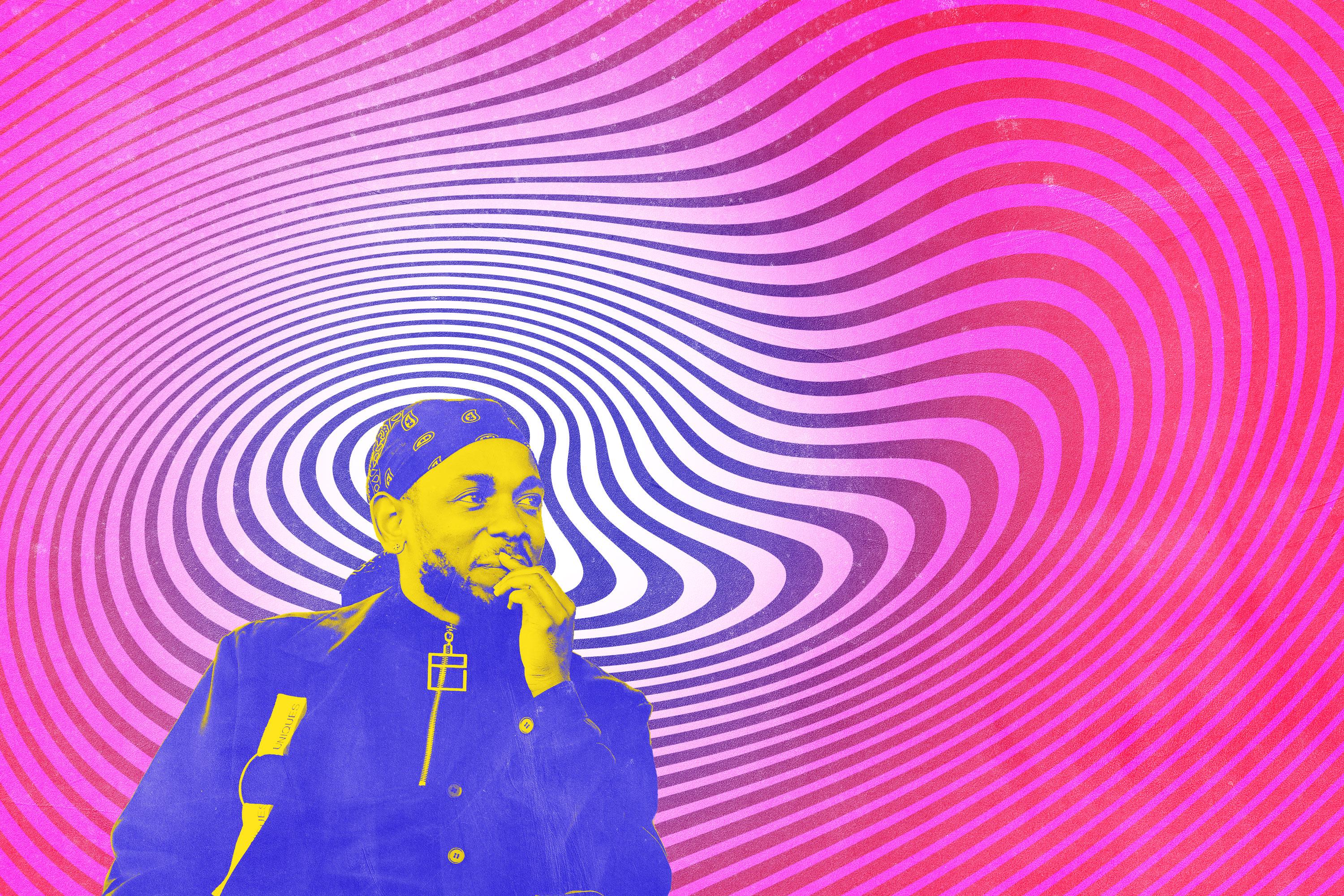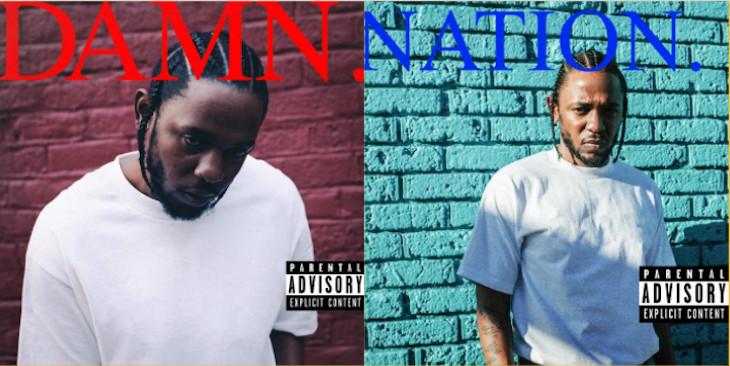
On December 8, Kendrick Lamar released the collector’s edition of his acclaimed 2017 album Damn. Most “collector’s editions” tend to be overpriced affairs bloated with B-sides, demos, and unnecessarily shiny packaging, but this one was different—just the same 14 songs from the original album, but with its tracklist arranged in reverse. It was an elegant flex: an assertion that the original songs are so great that the listener doesn’t need any bonus material, and that Damn. is so complex that eight months out from its release it still has some fresh secrets to whisper. But it was also confirmation of the long-held, much-discussed fan theory that Damn. is meant to be listened to back to front.
Damn. came out on Good Friday, April 14, 2017. Almost immediately, rumors circulated online that Kendrick, that benevolent rap messiah, would drop another new album on Easter Sunday. Someone speculated that the album would be called Nation., and just as quickly, a fake cover started to make the rounds, designed to look like a companion piece to Damn. (Get it? Damn … nation? Anyway.) On the first release, he stood in front of a red brick wall; the second’s wall was blue. The “M” in Damn. was positioned above Kendrick’s head in such a way that made it look like devil horns. Whoever Photoshopped the Nation. cover took pains to place the “O” in the same spot, like a halo. Because no internet conspiracy theory can exist without a connection to the Matrix, fans made much of the fact that the day before Damn. came out Kendrick’s collaborator Soundwave tweeted a picture of Morpheus. The red pill and blue pill takes practically wrote themselves.

By April 21, rumors about Nation. grew so loud that Kendrick had to dispel them himself. “KenFolk,” he tweeted. “ThankU 4 the desire of always anticipating new music of my own. None is coming. My work will be in our future TDE dates tho.” Kendrick fans on Reddit and other message boards, however, were already onto a new theory. Kendrick had released two albums: Damn. played frontward and Damn. played backward. In an extensive post arguing this theory at the rap blog Ambrosia for Heads, one writer called it a “double album within an album.”
I’d heard about it, of course, but until Kendrick released the collector’s edition. I hadn’t actually tried listening “14-1,” as the true heads say. I didn’t think it would make much of a difference—it all sounded a bit excessive to me. But then I tried it, and it took me only one listen to become a believer. I’d even go so far as to say that .Nmad is a better record than Damn.
When you play it as it was first released, Damn. begins with a death. The first track on the standard edition is “Blood.,” an ephemeral interlude in which Kendrick recounts a chilling dream: He meets a blind woman on the street and offers to help her, and rather than accept his assistance—“Oh yeah, you have lost something. … You’ve lost … your life.”—she shoots him dead. This gives a hallucinatory vibe to the 13 tracks that follow, as though it’s an otherworldly missive from the afterlife.
Kendrick Lamar tends to default to the loquacious and epic, but in this order, the first half of Damn. is probably the most concise and accessible stretch of music he’s ever released. These songs are muscular, aggressive, and catchy: There’s a duet with Rihanna (“Loyalty.”), a tenacious three-minute song of self (“DNA”), and the fiery hit that in April became Kendrick’s second Billboard Hot 100 no. 1 (“Humble.”). Even played on shuffle, Damn. is an embarrassment of riches, and the sprint between “DNA.” and “Humble.” has a breathlessness to it. You almost have to hit pause to process it all.
If you play it back to front, though (which some fans refer to as, I kid you not, “the Blue Album”), the album begins with “Duckworth.,” Damn.’s most conceptually ambitious song. It’s a bit of throwback storytelling rap recounting “the chicken incident,” an encounter that happened 20 years ago in Compton between Anthony “Top Dawg” Tiffith (the label head who first took a chance on Kendrick) and Kendrick’s dad, “Ducky.” Top Dawg was planning to rob the restaurant where Ducky worked. Ducky sensed something was up with this shady guy who kept hanging around, but rather than act aggressively, he gave him free food. Top Dawg took a liking to Ducky and eventually decided not to rob him. They went their separate ways and didn’t meet again until two decades later, when they were in the recording studio with Ducky’s talented, grown son Kendrick. On “Duckworth.,” that fateful child muses, “Whoever thought the greatest rapper would be from coincidence? Because if Anthony killed Ducky, Top Dawg could be servin’ life / While I grew up without a father and die in a gunfight.”
A heady beginning, for sure, but if you start with “Duckworth.,” Damn. is, all around, in less of a hurry. The early songs are slower, longer, more languid and introspective—which means that the record flows more like Kendrick’s everyday odyssey Good Kid, M.A.A.D. City. They also feel a little more chronological: “Duckworth.” largely takes place before his birth, parts of “God.” find young Kendrick dreaming of someday “shootin’ up the charts, better run, man,” and the incisive seven-minute “Fear.” finds a teenage Kendrick thinking, “I’ll prolly die anonymous / I’ll prolly die with promises / I’ll prolly die walkin’ back from the candy house / I’ll prolly die because these colors are standin’ out.”
The initial version of Damn. tells a more hopeful, conventionally satisfying narrative—always a good look when you’re trying to move as much product as possible. It follows a brash rap star as he looks inward and finally reconnects with his roots. “When we listen to the album in the order in which it was released,” Ambrosia for Heads notes, “it takes us down a path of gradual enlightenment. … The order of the song titles suggests the evolution. Kendrick moves from ‘Lust.’ to ‘Love.,’ ‘Pride.’ to being ‘Humble.,’ having ‘Fear.’ to feeling like a ‘God.’”
Maybe I like the “Blue” version better because it tells a darker, messier story. Rather than tie up loose ends, it unravels them into a fray, leading to a profoundly unsettling conclusion. The “Blue” version is no fairytale. Love warps into lust. The wise words of Cousin Carl (who we hear in a voicemail sampled on “Fear.”) are forgotten by the time Kendrick has made it to the carefree “Yah.” Success has made our cocky narrator forget where he came from, although it does make the penultimate track “DNA” more meaningful since we know where he’s been—we’ve taken the journey with him. We do not need to be told about the power, poison, pain, and joy because he’s already showed us all of their vivid hues.
Some people on the Kendrick Lamar subreddit (many of whom are very deep into the backward-tracklist theory) think that the “Blue” version of Damn. imagines what Kendrick’s life would have been if Top Dawg had shot Ducky, and if Kendrick had grown up without a mentor or a father. This is where there might be a danger in getting too caught up in the details: Some proponents of this theory argue over minutia like whether, in that version, all the references to Kendrick’s father must then be metaphorical, or about another male figure in his life. You certainly don’t have to look that deep into it to appreciate the reverse track order, though. Best to let the sound have mastery over you rather than the other way around. As with most music, it’s probably better to loosen your grip on the facts and let this version of the album wash over you as a slightly different way of hearing a collection of great, intricate songs.
There’s only one thing I don’t like about the reverse track order: It gives the last word to the disapproving Fox News commentators that Kendrick samples at the end of “Blood.” I cannot say I want Geraldo Rivera’s voice echoing in my brain at the conclusion of a Kendrick Lamar album. But maybe that’s the point. The shock of ending with the gunshot wound of “Blood.” serves as a reminder that, no matter how famous he becomes or how deeply he cultivates his talent, some people will only ever see Kendrick Lamar as a black man. That old teenage fear of dying “because these colors are standin’ out” turns out to be prophecy. He doesn’t die anonymous in this version of the tale, but what does it matter when all the success in the world cannot protect him from other people’s fear or from the fearful ones laying claim to his own story after he’s gone?
Almost daily, people claim that streaming is killing the album, bemoaning that nobody listens to music as attentively as they used to back in the days when fans would pore over the tracklists and liner notes inside LP sleeves. Damn. proves that this isn’t necessarily the case, especially when the album in question is this rich. The .Nmad Heads remind me a bit of those obsessive stoner pioneers who first realized how well Dark Side of the Moon synced up to the Wizard of Oz, or the Beatles fans who were convinced that the truth about Paul McCartney’s death would be revealed if you played the Beatles’ White Album backward.
And yet the nature of this type of listening does feel dependent on the way most people experience Damn., which is digitally. The impulse to understand and derive meaning from music hasn’t changed, but the medium has. When people talked about playing the White Album backward, they were talking about literally spinning the record backward on the turntable. Maybe it held all sorts of untold secrets if you played it from “Good Night” to “Back in the U.S.S.R.,” but it would have been such a pain in the ass to do that on a record player that you’d have had to have been a little obsessed to try.
The Damn. Backward phenomenon feels, to me, equal parts White Album and The Life of Pablo, the 2016 album that Kanye West continued to tweak and rearrange for weeks after its release, so much so that it became a kind of living album. The ultimate joke of Damn.’s collector’s edition is that it did not need to be released at all: It already existed in countless Spotify playlists and digital music libraries owned by fans who wanted to listen to it that way. It gives the listener a godly control over Kung Fu Kenny’s fate. It’s almost like a progress bar: Toggle it one way and he overcomes temptation and contemplates the lessons of family. Toggle the other way and he forgets and is shot down in the street. Is it wickedness? Is it weakness? You decide.